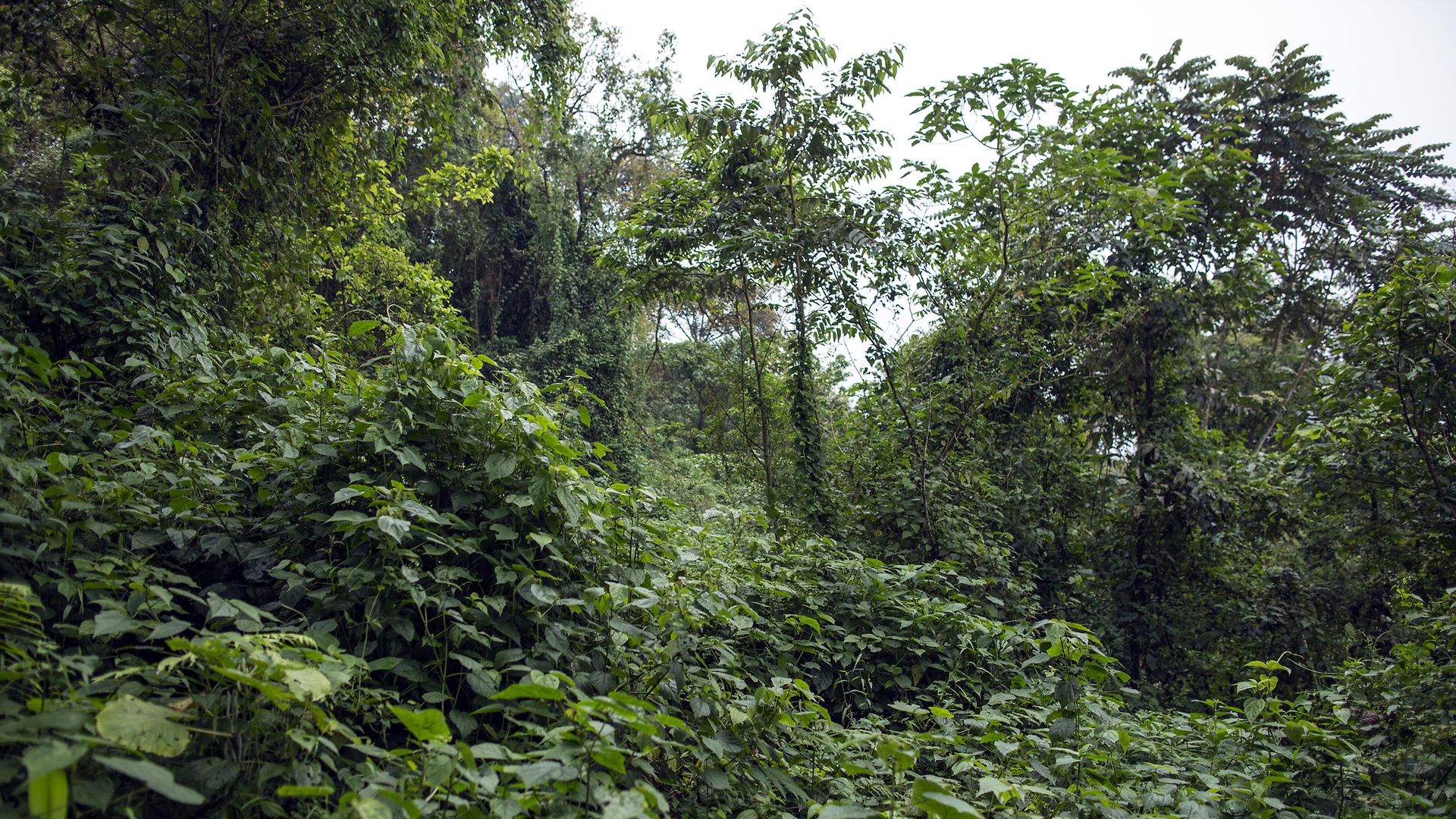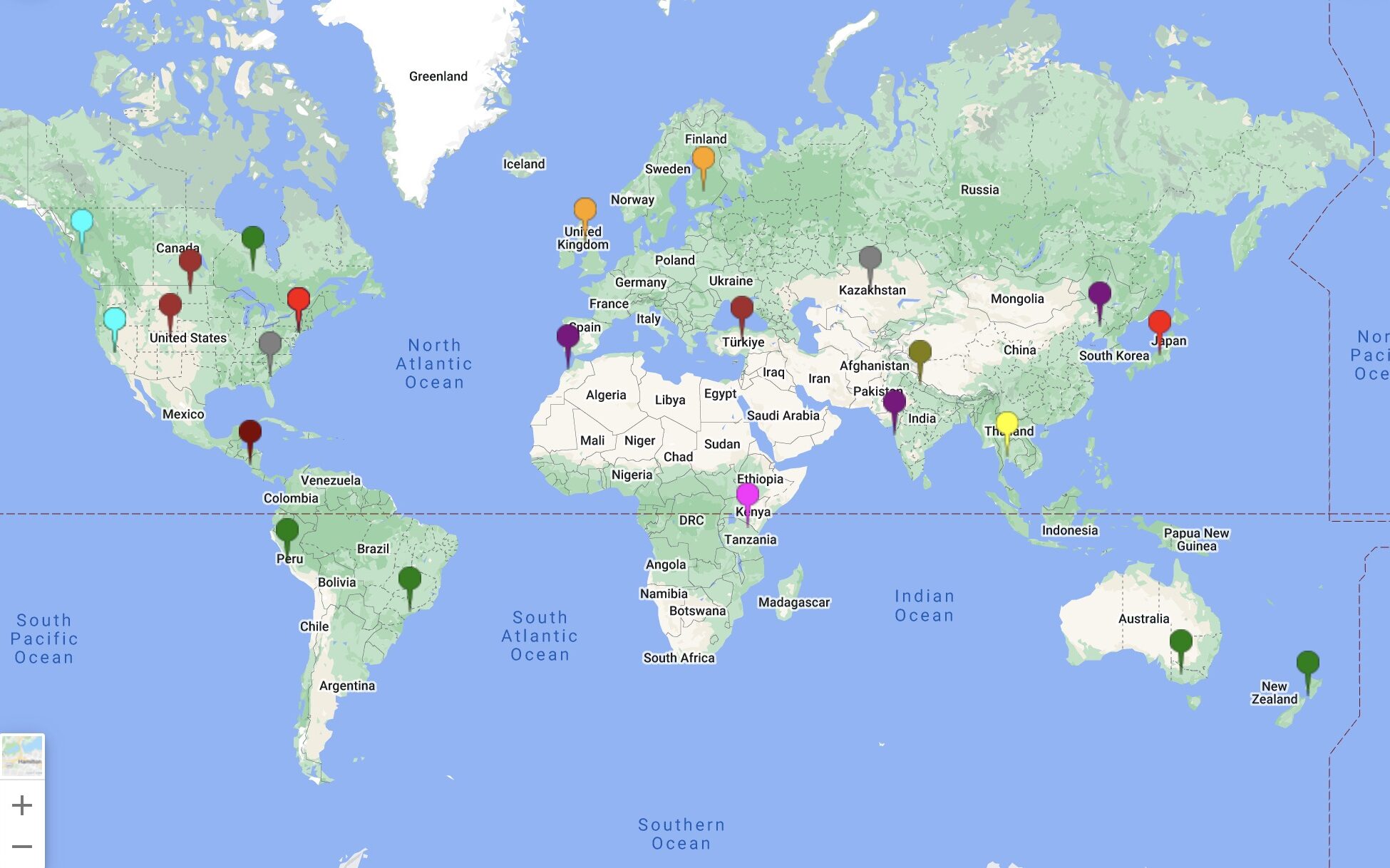Sustainability (497)
Children categories

Sustainable Development Goals (911)
The Sustainable Development Goals are a universal call to action to end poverty, protect the planet and improve the lives and prospects of everyone, everywhere. The seventeen Sustaiable Development Goals (SDG) were adopted by all UN Member States in 2015, as part of the 2030 Agenda for Sustainable Development which set out a 15-year plan to achieve the Goals.
 Cameroon’s vast and species-rich rainforests are of great importance for global biodiversity and the climate. They are also an important source of food and income for local people. A new study on hunting patterns in the jungles of West Africa includes research gathered by a University of Tennessee professor. Thomas Imo/German Federal Government
Cameroon’s vast and species-rich rainforests are of great importance for global biodiversity and the climate. They are also an important source of food and income for local people. A new study on hunting patterns in the jungles of West Africa includes research gathered by a University of Tennessee professor. Thomas Imo/German Federal Government
Adam Willcox subsisted on bush meat during African hunting study
Katie Donaldson is a communications specialist for the University of Tennessee School of Natural Resources.
KNOXVILLE — Data collected by a University of Tennessee research associate nearly 30 years ago is part of an extensive study that focuses on hunting patterns in African tropical forests.
Adam Willcox, a research associate professor in the UT Institute of Agriculture School of Natural Resources, co-authored the article, which was published recently in Nature Sustainability. “Regional patterns of wild animal hunting in African tropical forests” was also written by Daniel J. Ingram, research fellow at the University of Kent, and several other researchers. The data show how hunting management is needed to sustain wild animal populations in West and Central Africa.
The article uses data collected from 1991 to 2022 in 83 different studies to create a regional analysis of hunting patterns. Willcox contributed to the publication using research and data he gathered from 1996 to 2001 while promoting agroforestry in the U.S. Peace Corps in Cameroon. “I was in a lowland tropical forest. We did not have domestic alternatives for protein. We had to eat wild animals,” Willcox said. “My research followed 100 hunters around a wildlife sanctuary in Cameroon and their harvests.”
- university of tennessee professor ate research subjects
- adam willcox
- ut institute of agriculture
- human hunting patterns
- bush meat
- hunting management
- ut ag research
- nature sustainability
- wild animal populations in west and central africa
- biodiversity
- subsistence hunting
- agroforestry
- university of kent
Editorial: Old paradigms persist in proposed development of urban forest at UNC Asheville
Written by Noah Poulos UNC Asheville seems poised to develop a 45-acre forested tract in North Asheville into university amenities and housing. A grassroots movement has emerged to fight the proposal, such as Save the Woods, which has 3,000 members on Facebook. Save the Woods via social media
UNC Asheville seems poised to develop a 45-acre forested tract in North Asheville into university amenities and housing. A grassroots movement has emerged to fight the proposal, such as Save the Woods, which has 3,000 members on Facebook. Save the Woods via social media
The university indicates development of 45-acre wooded property is pending as community rallies
Noah Poulos is a farmer, writer, educator and UNC Asheville graduate who lives in Western North Carolina.
ASHEVILLE — Many have come to know a small forest in North Asheville as an extension of their home.
In these humble woods of the Experimental Forest, near a botanical park and U.S. Forest Service research station, pileated woodpeckers peck vigorously in the canopy. Towering pines dapple the light on the forest floor as day turns to dusk.
It is a place that has become a mainstay of this community and people are deeply connected to it — through stories, memories, relationships and a deep appreciation for what a small woodland can offer.
This forest, while open to the public, is owned by UNC Asheville, which recently shared plans to develop it for additional campus amenities.
Opposition has arisen to the university’s development plans, especially since a statement from the institution that strongly implies development will proceed as part of an overall expansion and revenue plan.
Industry-backed legislation would bar the science behind hundreds of environmental protections
Written by Sharon Lerner Trichloroethylene is among the chemicals deemed a serious public health risk by way of the Environmental Protection Agency’s IRIS database. Legislation in Congress could bar the use of IRIS and its associated scientific methods from being used to calculate the environmental and human health risks of chemicals such as TCE, a proven carcinogen. ChemLibrarian/Wikipedia Commons
Trichloroethylene is among the chemicals deemed a serious public health risk by way of the Environmental Protection Agency’s IRIS database. Legislation in Congress could bar the use of IRIS and its associated scientific methods from being used to calculate the environmental and human health risks of chemicals such as TCE, a proven carcinogen. ChemLibrarian/Wikipedia Commons
Two bills in Congress would prohibit the Environmental Protection Agency from using hundreds of chemical assessments completed by its IRIS program in environmental regulations or enforcement.
This story was originally published by ProPublica.
WASHINGTON, D.C. — For decades, Republican lawmakers and industry lobbyists have tried to chip away at the small program in the Environmental Protection Agency that measures the threat of toxic chemicals.
Most people don’t know IRIS, as the program is called, but it is the scientific engine of the agency that protects human health and the environment. Its scientists assess the toxicity of chemicals, estimating the amount of each that triggers cancer and other health effects. And these values serve as the independent, nonpartisan basis for the rules, regulations and permits that limit our exposure to toxic chemicals.
Now IRIS faces the gravest threat to its existence since it was created under President Ronald Reagan four decades ago.
Legislation introduced in Congress would prohibit the EPA from using any of IRIS’ hundreds of chemical assessments in environmental rules, regulations, enforcement actions and permits that limit the amount of pollution allowed into air and water. The EPA would also be forbidden from using them to map the health risks from toxic chemicals. The bills, filed in both the U.S. Senate and House of Representatives earlier this year, are championed by companies that make and use chemicals, along with industry groups that have long opposed environmental rules. If it becomes law, the “No IRIS Act,” as it’s called, would essentially bar the agency from carrying out its mission, experts told ProPublica.
“They’re trying to undermine the foundations for doing any kind of regulation,” said William Boyd, a professor at UCLA School of Law who specializes in environmental law. Boyd noted that IRIS reports on chemicals’ toxicity are the first step in the long process of creating legal protections from toxic pollutants in air and water.
“If you get rid of step one, you’re totally in the dark,” he said.
If the act passes, companies could even use the law to fight the enforcement of environmental rules that have long been on the books or permits that limit their toxic emissions, environmental lawyers said.
- iris
- propublica
- chemical regulation
- chemical pollution epa
- chemical database
- no iris act
- sharon lerner
- tce
- epa chemical regulations
- trump and environment
- environmental regulations
- carcinogens
- public health protection
- worst chemicals
- forever chemicals
- propublic environment
- propublica environment reporting
- best environmental reporting
- integrated risk information system
- toxic pollution
- environmental protection agency
Butterflies decline by 20 percent since 2000 due in large part to pesticide use
Written by Eliza Grames A postman butterfly feeds on a bloom in the Tennessee Aquarium’s Butterfly Garden in Chattanooga. At any one time, the garden may host 1,000 to 1,500 butterflies representing more than 200 species. Courtesy Tennessee Aquarium
A postman butterfly feeds on a bloom in the Tennessee Aquarium’s Butterfly Garden in Chattanooga. At any one time, the garden may host 1,000 to 1,500 butterflies representing more than 200 species. Courtesy Tennessee Aquarium
A third of species declined by half in U.S.; relatively simple steps can improve outlook
This story was originally published by The Conversation.
If the joy of seeing butterflies seems increasingly rare these days, it isn’t your imagination.
From 2000 to 2020, the number of butterflies fell by 22% across the continental United States. That’s 1 in 5 butterflies lost. The findings are from an analysis just published in the journal Science by the U.S. Geological Survey’s Powell Center Status of Butterflies of the United States Working Group, which I am involved in.
We found declines in just about every region of the continental U.S. and across almost all butterfly species.
Overall, nearly one-third of the 342 butterfly species we were able to study declined by more than half. Twenty-two species fell by more than 90 percent. Only nine actually increased in numbers.
Some species’ numbers are dropping faster than others. The West Coast lady, a fairly widespread species across the western U.S., dropped by 80 percent in 20 years. Given everything we know about its biology, it should be doing fine — it has a wide range and feeds on a variety of plants. Yet its numbers are absolutely tanking across its range.
Updated 4/18: Smoky gray: Former Smokies leader warns of more funding cuts; popular campsites remain closed; still little information on cuts at Great Smoky Mountains National Park
Written by Elan Young, Ben Pounds and Thomas Fraser Campers are seen enjoying a morning at Elkmont Campground in Great Smoky Mountains National Park. Elkmont is one of the Smokies campgrounds still open. National Park Service
Campers are seen enjoying a morning at Elkmont Campground in Great Smoky Mountains National Park. Elkmont is one of the Smokies campgrounds still open. National Park Service
National parks advocate and former Smokies official warns of funding shortfalls as closures continue, concerns persist, and people resist
KNOXVILLE — Funding for national parks has never amounted to much, and the federal government will cut even more if people don’t speak out in defense of the country’s natural and ecological crown jewels.
That was the message from Phil Francis, chairman of the Coalition to Protect American National Parks and former acting superintendent of Great Smoky Mountains National Park. He spoke to an audience at Knoxville’s Schulz Bräu Brewing Company hosted by Discover Life in America. Francis said that due to rising concerns his organization grew from 500 members to over 4,000 during the Trump administration. The coalition, he said, includes many people like himself who used to work for the park system, including the former superintendent of Acadia National Park.
Francis advocated that others should lobby government officials to continue to support the parks.
“If you don’t speak up, it makes it a lot more difficult,” he told the audience.
- elan young
- smokies job cuts
- federal job cuts
- rangers
- smokies rangers fired
- how many lost jobs at smokies
- smokies parking fees
- great smoky mountains economic impact
- national parks conservation association
- association of national park rangers
- hellbender press reporting on job cuts
- probationary workers fired
- great smoky mountains national park
- big south fork national river and recreation area
- maintenance backlog
- jeff hunter
- bill wade
- cades cove loop road
- carfree experience in cades cove
- carfree wednesdays in cades cove
- garry shores
- townsend
- townsend protest
- gatlinburg protest
- phil francis
- discover life in america
- ben pounds
- national park funding
- trump national park cuts
 Debris hangs from trees on the banks of the French Broad River near the main building of Hot Springs Resort and Spa. The river gauge at Hot Springs was offline during the main rain events immediately preceding the Sept. 27, 2024 floods but registered a peak just under 21 feet. The record stage is 22 feet, but that record will likely fall after review of provisional weather-gauge data by the National Weather Service. Much of the debris generated by flooding on the French Broad River in Western North Carolina made its way downstream toward Douglas Lake in Tennessee. Thomas Fraser/Hellbender Press
Debris hangs from trees on the banks of the French Broad River near the main building of Hot Springs Resort and Spa. The river gauge at Hot Springs was offline during the main rain events immediately preceding the Sept. 27, 2024 floods but registered a peak just under 21 feet. The record stage is 22 feet, but that record will likely fall after review of provisional weather-gauge data by the National Weather Service. Much of the debris generated by flooding on the French Broad River in Western North Carolina made its way downstream toward Douglas Lake in Tennessee. Thomas Fraser/Hellbender Press
Volunteers needed for 36th Ijams River Rescue set for March 8
KNOXVILLE — The thousand-year rains brought by Hurricane Helene flushed incalculable amounts of garbage from multiple major watersheds in East Tennessee and Western North Carolina in late September 2024. The Tennessee Wildlife Resources Agency and Tennessee Valley Authority, for instance, resorted to booms and cranes to corral and collect thousands of tons of garbage along more than 200 miles of Douglas Lake shoreline. The cleanup continues.
High water downstream also carried debris and detritus of every description into Knox County via the French Broad River, which then deposited it along urban and regional lake and stream banks.
Removing this pulse of pollution and flotsam from the Tennessee River, already known as a conduit of microplastics, could take years or generations. You can start the process March 8 along multiple TVA lakes in the area. We all live downstream.
Here’s the release from Ijams Nature Center, one of the main sponsors of the annual event:
Volunteer and make your community a cleaner, healthier place to live, work and play during the 36th annual Ijams River Rescue from 10 a.m. to 1 p.m. Saturday, March 8. A severe weather date is set for Saturday, March 15.
Ijams Nature Center’s annual cleanup event brings together hundreds of individuals, families, Scout troops, businesses and church groups to remove tons of trash and tires from sites along the Tennessee River, creeks and streams. Sites are typically located in Knox, Anderson and Blount counties.
Updated 2/28: Energy secretary on visit to an uncertain Oak Ridge shrugs at climate change; offers little concrete update on federal cuts
Written by Ben PoundsU.S. Sen. Bill Hagerty, R-Tenn.; U.S. Secretary of Energy Chris Wright; Rep. Chuck Fleischmann; R-Chattanooga; and Open AI CEO Greg Brockman spoke with the press during a tour of Oak Ridge-area nuclear facilities. Ben Pounds/Hellbender Press
Visit by energy secretary doesn’t address program cuts as former fracking CEO downplays climate change threat; visit comes following diversity program cuts; full extent of Oak Ridge impacts still unknown
Hellbender Press typically avoids the use of anonymous sources. The sources in this story spoke on condition they not be identified so they could speak on a sensitive matter.
This story will be updated. The original stories continue below.
OAK RIDGE — U.S. Secretary of Energy Chris Wright denied that climate change was a “crisis” and downplayed its threat during a visit to an international hub of scientific expertise rattled by early actions of the second Trump Administration. His visit did little to allay fears of cuts to staff and programs at Oak Ridge National Laboratory, where the most concrete signs of change have been the dismantling of diversity efforts.
Wright visited ORNL on Feb. 28, and at a press conference defended the Trump administration’s actions on climate change, energy sources and the Department of Government Efficiency (DOGE), a group headed by Elon Musk that has recommended cutting programs and staff in various government departments.
He did not announce any layoffs at the lab itself, however, and implied research related to climate there will continue. Oak Ridge National Laboratory is home to many kinds of related research, including at the Climate Change Science Institute. CCSI does modeling and gathers data on the climate, as well as working on solutions to the problem.
Wright promoted research on artificial intelligence, which he called “Manhattan Project II,” and nuclear energy, and he appeared alongside Sen. Bill Hagerty, R-Tenn., Rep. Chuck Fleischmann R-Chattanooga and Open AI CEO Greg Brockman, who also spoke and answered questions.
“I don’t think you’ll see any reduction in the science that we do regarding climate change or any of these other really big questions,” said Wright in response to a reporter’s questions about how cuts at the lab might affect climate change-related research at ORNL, which his department funds through a partnership with contractor Battelle and the University of Tennessee. He said, however, he still “100 percent” believed there was no climate “crisis” and said scientific reports backed up his view.
“We haven’t seen an increase in the frequency or intensity of hurricanes, floods, droughts, storms. Wildfires are on an uptick because we stopped managing our forests,” he said. “Deaths from extreme weather, which is what you hear the press and politicians’ fearmongering about, it declined over 90 percent in my lifetime as the population’s grown. So climate change is a real phenomenon. It’s just not even remotely close to the world’s biggest problem.” He also said an intergovernmental climate change report also showed economists saying climate change was not as important as issues like education, free trade and “empowerment.”
These claims are a mixed bag of truth. While the frequency of hurricanes hitting the United States, for example, hasn’t increased, a recent Columbia University study showed the tropical cyclones’ intensity for the East and Gulf Coasts has. Also unmentioned by Wright was any impact the climate has on disease or health conditions apart from extreme weather, a subject on which experts at Tennessee’s own Vanderbilt University have sounded the alarm.
Wright was CEO of a hydraulic fracking company, Liberty Energy, before his appointment.
“It’s a real thing, but nothing in the science of climate change or in the economics of climate change shows it to be the world’s biggest problem,” Wright said. “When you call something a crisis, it means we don’t have time to stop and think. We’ve just got to take action. That’s exactly the opposite of what climate science is.”
During the meeting, he also defended Musk, DOGE and Trump’s actions generally while not announcing any such cuts for the civilian research at Oak Ridge National Laboratory or the weapons maintenance at Y-12, which is managed by a different contractor. A reporter at the event mentioned an earlier instance in which workers at Y-12 National Security Complex received termination letters that were then rescinded. While the reporter asked him to offer reassurance on job security, he sidestepped that question.
- doge oak ridge
- doge cuts in oak ridge
- oak ridge national laboratory climate change institute
- did oak ridge get doge cuts
- trump and environment
- ornl jobs
- ornl employee meeting
- doe diversity
- doe office of science
- stephen streiffer
- inflation reduction act clean energy
- doe science focus
- ben pounds
- ornl source
- climate change
- is climate change real?
- chris wright
- energy secretary chris wright
- greg brockman
- open ai
Helene: Haul water, rescue pigs, help neighbors: How Warren Wilson College students confronted climate chaos
Written by Mallory McDuff A student farm leader takes care of pigs at Warren Wilson College in Swannanoa. Most of the college’s pigs were recovered following fatal flooding from the Swannanoa River on Sept. 28, 2024. Warren Wilson College
A student farm leader takes care of pigs at Warren Wilson College in Swannanoa. Most of the college’s pigs were recovered following fatal flooding from the Swannanoa River on Sept. 28, 2024. Warren Wilson College
Collective action helps alleviate climate anxiety in wake of Hurricane Helene
This story was originally published by The Revelator.
Mallory McDuff teaches environmental education at Warren Wilson College.
SWANNANOA, N.C. — “We need 10 people on flush crew, five to clean out the fridges in the science building, and 15 to clear trees on the roads! We’re gonna do this together!”
This wasn’t a pep rally or a community service event. It was the morning meeting called at 9:30 a.m. each day by campus leaders in front of the cafeteria at the small college where I lived without power or water, after the climate disaster of Hurricane Helene devastated our community in Western North Carolina.
“We know the Swannanoa Valley has been hit especially hard,” the college president told the group of students and employees. “And we are here for this college and for the greater community. This is our work together.”
That day I joined my neighbor Tom Lam chain-sawing his way across campus with a crew of students clearing brush along the way.
“Now gather ‘round so you can see how to sharpen this chainsaw,” Tom said in his booming Jersey voice, pulling on his suspenders after we’d cleared trees that crushed a neighbor’s car.
I’ve spent 25 years teaching environmental education, raising two daughters, and living at this 1,000-acre campus where all students work in jobs in places like the farm, garden, forests, and even fiber arts. And I think this might be one model of how to live in community in a climate emergency.
- how to live in community in a climate emergency
- warren wilson college
- hurricane helene warren wilson
- hurricane helene
- hurricane helene local impacts
- swannanoa
- swannanoa river
- mallory mcduff
- hurricane helene livestock
- climate emergency
- climate activist
- was warren wilson hit by hurricane
- what did warren wilson do during hurricane
- extreme weather
- southern appalachians natural disaster
UT scientists help decode the DNA of an iconic American tree
Written by Patricia McDaniels This white oak (Quercus alba) in Burlington, N.J. is known as the Keeler Oak. It is an estimated 300 years old and is emblematic of the role these massive trees can play in the forest and beyond. The white oak is a highly valuable tree, both economically and ecologically. Its seedling survival rate is declining, but University of Tennessee researchers joined others to map the species’ DNA. Wikipedia Commons
This white oak (Quercus alba) in Burlington, N.J. is known as the Keeler Oak. It is an estimated 300 years old and is emblematic of the role these massive trees can play in the forest and beyond. The white oak is a highly valuable tree, both economically and ecologically. Its seedling survival rate is declining, but University of Tennessee researchers joined others to map the species’ DNA. Wikipedia Commons
New research involving University of Tennessee describes the genome of the mighty white oak
Patricia McDaniels is news and information manager for the University of Tennessee Institute of Agriculture.
KNOXVILLE — Highly valued economically, ecologically and culturally, the white oak (Quercus alba) is a keystone forest species and is one of the most abundant trees across much of eastern North America. It also faces declining seedling recruitment in many parts of its range.
In a paper published in New Phytologist, researchers representing the University of Tennessee Institute of Agriculture, Indiana University, the University of Kentucky, the U.S. Forest Service and several more institutions described for the first time the species’ complex genome, providing insights into fundamental questions about plant evolution, tree breeding and genetic improvement efforts that could help forest managers plan for and address future forest resources.
Lead authors of the paper Meg Staton, associate professor of bioinformatics and computational genomics in the UT Department of Entomology and Plant Pathology, and Drew Larson, National Science Foundation postdoctoral fellow at Indiana University, coordinated with colleagues across the nation in academia, the U.S. Forest Service, state forests and industry to obtain genetic sequence data representative of the species.
Also central to the effort were Seth DeBolt, professor of horticulture and director of the James B. Beam Institute for Kentucky Spirits at the University of Kentucky, and Dana Nelson of the U.S. Forest Service Southern Research Station and director of the Forest Health Research and Education Center at the University of Kentucky.
White oak barrels are lifeblood to the bourbon industry because the color and much of the whiskey’s flavor derive from the charred wood in which it is aged.
- meg staton
- seth debolt
- loretto, kentucky
- makers mark
- independent stave company
- white oak
- quercus
- new phytologist
- patricia mcdaniels
- utia
- utia tree program
- University of Tennessee Agricultural Institute
- quercus alba
- scott schlarbaum
- genome
- bioinformatics
- computational genomics
- genetic sequencing
- gene annotation
- gene evolution
- genetic diversity
- tree improvement program
- phylogenetics
- bourbon whiskey
- oak barrel
Join the world’s largest biodiversity-related participatory science project!
Written by Cornell Lab of Ornithology
Great Backyard Bird Count (GBBC) weekend is underway
Each February, for four days, the world comes together for the love of birds. Over these four days people everywhere are invited to spend time in their favorite places watching and counting as many birds as they can find and reporting them to us. These observations help scientists better understand global bird populations before one of their annual migrations.
Participating is easy, fun to do alone or with others, and can be done anywhere you find birds.
Step 1: Decide where you will watch birds.
Step 2: Watch birds for 15 minutes or more, at least once over the four days, February 14–17, 2025.
Step 3: Identify all the birds you see or hear within your planned time/location and use the best tool for sharing your bird sightings:
- If you are a beginning bird admirer and new to bird identification, try using the Merlin Bird ID app to tell us what birds you are seeing or hearing.
- If you have participated in the count before and want to record numbers of birds, try the free eBird Mobile app or enter your bird list on the eBird website (desktop/laptop/smartphone).
If you already use Merlin or eBird, all entries over the 4 days count towards GBBC. Keep doing what you are doing! No need to register or sign-up separately for GBBC.
Note that the Great Backyard Bird Count and Project Feeder Watch are two different projects. Their observations are recorded separately. However, if you are enrolled in Project Feeder Watch and your observation days overlap with the GBBC period, you can choose to designate your feeder also as a stationary GBBC count location and submit your feeder observations to both projects. The principal purpose of GBBC, though, is to identify all birds one can see and hear. Because relatively few species of birds are attracted by feeders, it is important to obtain counts from locations beyond your feeder and beyond your own backyard to gain a better understanding of bird biodiversity.
More...
Up from South Chickamauga: Paddle Georgia to celebrate 20th anniversary with first Tennessee River journey
Written by Tennessee RiverLine
Weeklong paddling event highlights Tennessee RiverLine; registration open for June adventure
KNOXVILLE — Paddle Georgia, the renowned multi-day paddling adventure, is celebrating its 20th anniversary with a historic first: an expedition along the Tennessee River, traveling through Georgia, Tennessee and Alabama. More than 300 paddlers are expected to take part in the journey June 15-22, immersing themselves in the beauty, history and vibrant communities of the Tennessee River Valley. The event will highlight the Tennessee RiverLine, an initiative of University of Tennessee Extension that reframes the 652-mile Tennessee River as a continuous system of outdoor recreation experiences.
(Hellbender Press previously reported on the Tennessee RiverLine.)
The Tennessee RiverLine is assisting with trip planning resources for this milestone event, reinforcing its mission to transform the Tennessee River into a continuous system of outdoor recreation experiences and showcasing the river’s potential as a premier destination for adventure tourism.
“We are thrilled to collaborate with Georgia Rivers on the 20th anniversary of Paddle Georgia and welcome them to the Tennessee RiverLine,” said Brad Collett, executive director of Tennessee RiverLine. “This journey exemplifies our shared commitment to connecting people with the river, fostering environmental stewardship and celebrating the natural and cultural heritage of the Tennessee River Valley. We look forward to working together to bring this transformative experience to life.”
The seven-day adventure will begin in Ringgold, Georgia, on the South Chickamauga Creek Water Trail, a narrow watercourse that flows beneath spectacular limestone bluffs, over playful rapids and (unusually) underground before emptying into the Tennessee River just east of Chattanooga.
- paddle georgia
- tennessee riverline
- tennessee river paddling
- tennessee river tourism
- chattanooga paddling
- camping on tennessee river
- university of tennessee extension
- outdoor recreation
- outdoor recreation economy
- south chickamauga
- nickajack cave wildlife refuge
- nickajack lock
- georgia rivers
- south chickamauga creek water trail
- ringgold, ga
Stand in the Middle at McClung Museum
 Clint Carroll, a citizen of the Cherokee Nation, will talk Feb. 27 at McClung Museum about the Cherokee philosophy of the ‘Middle Way.’
Clint Carroll, a citizen of the Cherokee Nation, will talk Feb. 27 at McClung Museum about the Cherokee philosophy of the ‘Middle Way.’
KNOXVILLE — A central aspect of Cherokee worldview is ᎠᏰᎵ ᎦᏙᎬ (ayehli gadogv), or “Standing in the Middle,” a philosophy that humans occupy a role in a web of complex interactions between mutually dependent organisms. Standing in the Middle emphasizes the importance of balance and reciprocity in persisting relationships.
A lecture at 4:30 p.m. Feb. 27 at McClung Museum, 1327 Circle Park, Knoxville, will feature Dr. Clint Carroll, who will explore how Standing in the Middle informs ecology, conservation, management practices, epistemology and science communication in the face of unprecedented anthropogenic (human-caused) change.
Light refreshments will be available before the lecture.
Clint Carroll is associate professor of Ethnic Studies at the University of Colorado Boulder. A citizen of the Cherokee Nation, he works closely with Cherokee people in Oklahoma on issues of land conservation and the perpetuation of land-based knowledge and ways of life.
February Green Drinks meetup highlights TennGreen

KNOXVILLE — Meet representatives of a budding land conservancy and raise a glass and network to support conservation.
This month’s installment of Green Drinks Knoxville, is set for 7-8 p.m. Feb. 12, 2025 at Albright Grove Brewing Company, 2924 Sutherland Ave.
This meetup Knoxville features TennGreen Land Conservancy Executive Director Alice Hudson Pell and Matthew McClanahan, East Tennessee Vice President. They will share updates on current projects and TennGreen’s 2024-2029 Strategic Plan.
2025 Keep Knoxville Beautiful Annual Summit

6th Annual Summit on February 7, 2025!
Lunch will be included for all attendees from Brown Bag.
There is a limited number of tickets available. We anticipate this event selling out, so get your ticket while you can!